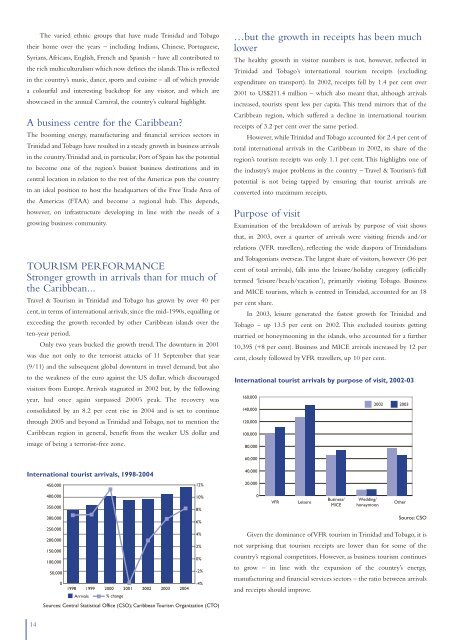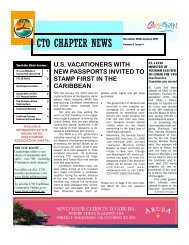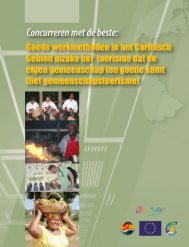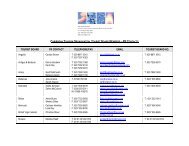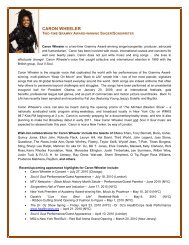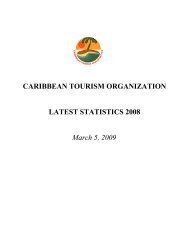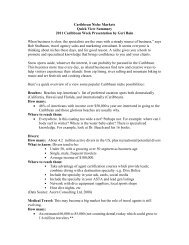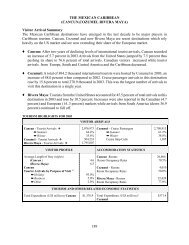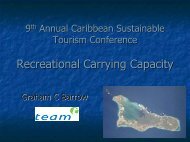TRINIDAD AND TOBAGO - Caribbean Tourism Organization
TRINIDAD AND TOBAGO - Caribbean Tourism Organization
TRINIDAD AND TOBAGO - Caribbean Tourism Organization
You also want an ePaper? Increase the reach of your titles
YUMPU automatically turns print PDFs into web optimized ePapers that Google loves.
14<br />
The varied ethnic groups that have made Trinidad and Tobago<br />
their home over the years – including Indians, Chinese, Portuguese,<br />
Syrians,Africans, English, French and Spanish – have all contributed to<br />
the rich multiculturalism which now defines the islands.This is reflected<br />
in the country’s music, dance, sports and cuisine – all of which provide<br />
a colourful and interesting backdrop for any visitor, and which are<br />
showcased in the annual Carnival, the country’s cultural highlight.<br />
A business centre for the <strong>Caribbean</strong>?<br />
The booming energy, manufacturing and financial services sectors in<br />
Trinidad and Tobago have resulted in a steady growth in business arrivals<br />
in the country.Trinidad and, in particular, Port of Spain has the potential<br />
to become one of the region’s busiest business destinations and its<br />
central location in relation to the rest of the Americas puts the country<br />
in an ideal position to host the headquarters of the Free Trade Area of<br />
the Americas (FTAA) and become a regional hub. This depends,<br />
however, on infrastructure developing in line with the needs of a<br />
growing business community.<br />
TOURISM PERFORMANCE<br />
Stronger growth in arrivals than for much of<br />
the <strong>Caribbean</strong>...<br />
Travel & <strong>Tourism</strong> in Trinidad and Tobago has grown by over 40 per<br />
cent, in terms of international arrivals, since the mid-1990s, equalling or<br />
exceeding the growth recorded by other <strong>Caribbean</strong> islands over the<br />
ten-year period.<br />
Only two years bucked the growth trend.The downturn in 2001<br />
was due not only to the terrorist attacks of 11 September that year<br />
(9/11) and the subsequent global downturn in travel demand, but also<br />
to the weakness of the euro against the US dollar, which discouraged<br />
visitors from Europe. Arrivals stagnated in 2002 but, by the following<br />
year, had once again surpassed 2000’s peak. The recovery was<br />
consolidated by an 8.2 per cent rise in 2004 and is set to continue<br />
through 2005 and beyond as Trinidad and Tobago, not to mention the<br />
<strong>Caribbean</strong> region in general, benefit from the weaker US dollar and<br />
image of being a terrorist-free zone.<br />
International tourist arrivals, 1998-2004<br />
450,000<br />
400,000<br />
350,000<br />
300,000<br />
250,000<br />
200,000<br />
150,000<br />
100,000<br />
50,000<br />
■<br />
■<br />
■<br />
0<br />
■<br />
1998 1999 2000 2001 2002 2003 2004<br />
Arrivals ■ % change<br />
Sources: Central Statistical Office (CSO); <strong>Caribbean</strong> <strong>Tourism</strong> <strong>Organization</strong> (CTO)<br />
■<br />
■<br />
■<br />
12%<br />
10%<br />
8%<br />
6%<br />
4%<br />
2%<br />
0%<br />
-2%<br />
-4%<br />
…but the growth in receipts has been much<br />
lower<br />
The healthy growth in visitor numbers is not, however, reflected in<br />
Trinidad and Tobago’s international tourism receipts (excluding<br />
expenditure on transport). In 2002, receipts fell by 1.4 per cent over<br />
2001 to US$211.4 million – which also meant that, although arrivals<br />
increased, tourists spent less per capita. This trend mirrors that of the<br />
<strong>Caribbean</strong> region, which suffered a decline in international tourism<br />
receipts of 3.2 per cent over the same period.<br />
However, while Trinidad and Tobago accounted for 2.4 per cent of<br />
total international arrivals in the <strong>Caribbean</strong> in 2002, its share of the<br />
region’s tourism receipts was only 1.1 per cent.This highlights one of<br />
the industry’s major problems in the country – Travel & <strong>Tourism</strong>’s full<br />
potential is not being tapped by ensuring that tourist arrivals are<br />
converted into maximum receipts.<br />
Purpose of visit<br />
Examination of the breakdown of arrivals by purpose of visit shows<br />
that, in 2003, over a quarter of arrivals were visiting friends and/or<br />
relations (VFR travellers), reflecting the wide diaspora of Trinidadians<br />
and Tobagonians overseas.The largest share of visitors, however (36 per<br />
cent of total arrivals), falls into the leisure/holiday category (officially<br />
termed ‘leisure/beach/vacation’), primarily visiting Tobago. Business<br />
and MICE tourism, which is centred in Trinidad, accounted for an 18<br />
per cent share.<br />
In 2003, leisure generated the fastest growth for Trinidad and<br />
Tobago – up 13.5 per cent on 2002. This excluded tourists getting<br />
married or honeymooning in the islands, who accounted for a further<br />
10,395 (+8 per cent). Business and MICE arrivals increased by 12 per<br />
cent, closely followed by VFR travellers, up 10 per cent.<br />
International tourist arrivals by purpose of visit, 2002-03<br />
160,000<br />
140,000<br />
120,000<br />
100,000<br />
80,000<br />
60,000<br />
40,000<br />
20,000<br />
0<br />
VFR Leisure<br />
Business/<br />
MICE<br />
Wedding/<br />
honeymoon<br />
2002 2003<br />
Other<br />
Source: CSO<br />
Given the dominance of VFR tourism in Trinidad and Tobago, it is<br />
not surprising that tourism receipts are lower than for some of the<br />
country’s regional competitors. However, as business tourism continues<br />
to grow – in line with the expansion of the country’s energy,<br />
manufacturing and financial services sectors – the ratio between arrivals<br />
and receipts should improve.


